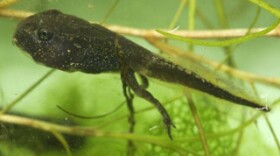Discover nature this week in the belted kingfisher.
If you’ve spent much time along Missouri’s streams, you’ve probably heard the chattering call of the belted kingfisher. Missouri Department of Conservation biologist, Danny Brown, wrote about the belted Kingfisher for Missouri’s Conservationist Magazine. He described the bird as one of Missouri’s avian jewels, which you can see for yourself this summer if you keep watch along Missouri’s streams.
The kingfisher is often heard before it is seen as it sends out a relentless rattle as soon as it takes wing. Dressed in slate blue, with a white collar and chest, the kingfisher is a striking bird. The female has a rust-colored band across her chest and both sexes have a white spot in front of each eye. A bit larger than a blue jay, the kingfisher has a long bill, perfectly designed to snatch fish from the water, and a comical tuft of feathers on its head. Belted kingfishers are year round residents of Missouri, and they nest in burrows along vertical stream banks so they can be close to their food source.
As its name implies, the belted kingfisher prefers fish, but it also feeds on crayfish and frogs as well as other small prey. Typically, the kingfisher lands on a branch about 15–20 feet over the water where it searches for a potential meal. When movement catches its eye, it flies toward the water, stopping abruptly a few feet above the surface where it hovers as it zeros in on an individual fish. Finally, the kingfisher dives into the water and snatches up its meal. The catch is then carried to a perch and swallowed whole.
A wary bird, the belted kingfisher often lands high in the trees and does not like humans to be in close proximity. If you wish to photograph the belted kingfisher, Brown recommends head to toe camouflage and lots of patience.
To find more information on Missouri birds, go online to mdc.mo.gov.





